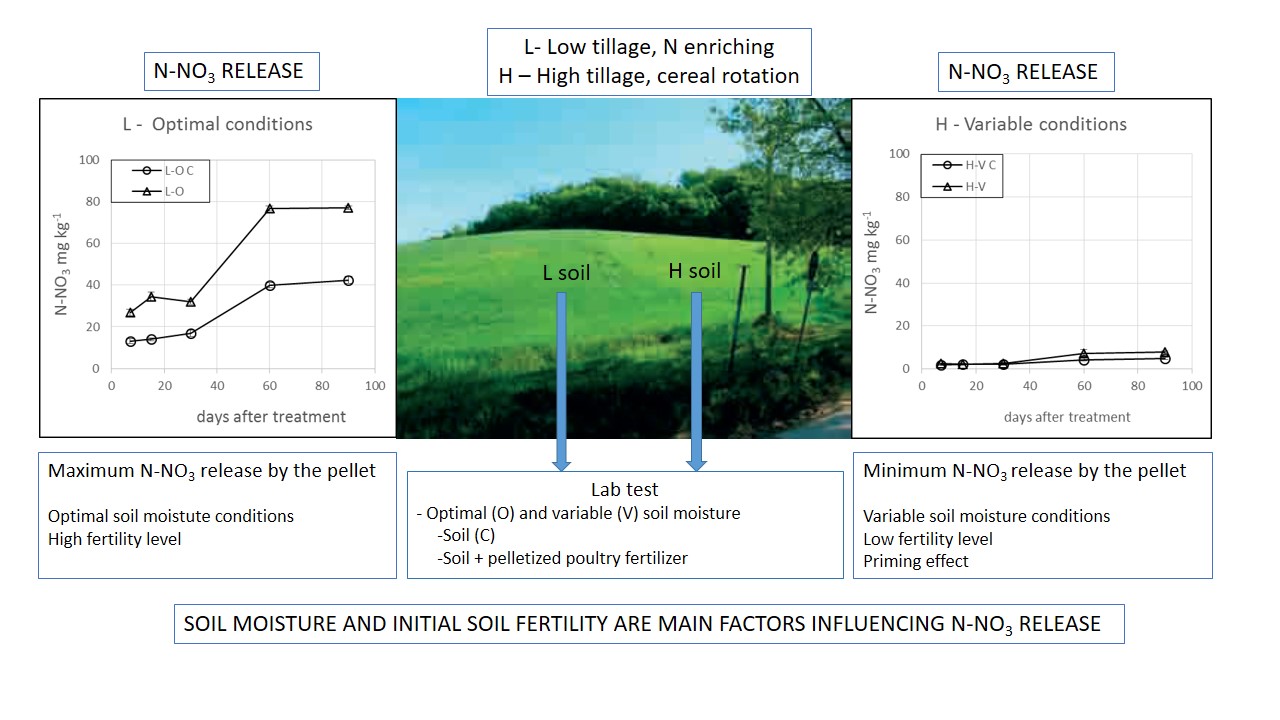Nitrogen release from pelletized poultry fertilizer in two soils: influence of soil moisture and microbial biomass
28/Jan/2022
ABSTRACT Nitrogen release from organic amendments, e.g., from organic agriculture, is a key process to raise soil fertility to sustain crop production in low environmental impact agroecosystems. This study aimed to investigate nitrogen release from a pelletized organic amendment containing poultry litter, guano and pot ale applied to soil from a field under two different management systems: an alfalfa-based crop rotation, enriched with N by the legume, under low-intensity tillage and a cereal-sunflower crop rotation under high-intensity tillage. Both sample […]
Soil quality indicators in a rhodic kandiudult under different uses in northern Parana, Brazil
01/Feb/2014
Sustainable use of soil, maintaining or improving its quality, is one of the goals of diversification in farmlands. From this point of view, bioindicators associated with C, N and P cycling can be used in assessments of land-use effects on soil quality. The aim of this study was to investigate chemical, microbiological and biochemical properties of soil associated with C, N and P under different land uses in a farm property with diversified activity in northern Parana, Brazil. Seven areas […]
Biochemical and chemical attributes of rhizospheric and non-rhizospheric soil in no till crop rotation system
01/Dec/2012
Self-sustaining systems encourage microbial populations due to the conservation and improvement of organic matter in the soil. In addition, the plants constituents of these systems produce the rhizospheric effect through the influence zone of the roots, increasing activity and modifying the microbial population. The objective of this study was to evaluate the effect of winter crop rotation and summer crop sequences in a no tillage system, based on biochemical (amylase, urease, cellulase, and protease) and chemical (organic carbon, total carbohydrates, […]
Chemical and biochemical properties of Araucaria angustifolia (Bert.) Ktze. forest soils in the state of São Paulo
01/Aug/2012
Araucaria angustifolia, commonly named Araucaria, is a Brazilian native species that is intensively exploited due to its timber quality. Therefore, Araucaria is on the list of species threatened by extinction. Despite the importance of soil for forest production, little is known about the soil properties of the highly fragmented Araucaria forests. This study was designed to investigate the use of chemical and biological properties as indicators of conservation and anthropogenic disturbance of Araucaria forests in different sampling periods. The research […]
Enzymatic activity and mineralization of carbon and nitrogen in soil cultivated with coffee and green manures
01/Oct/2010
There are great concerns about degradation of agricultural soils. It has been suggested that cultivating different plant species intercropped with coffee plants can increase microbial diversity and enhance soil sustainability. The objective of this study was to evaluate enzyme activity (urease, arylsulfatase and phosphatase) and alterations in C and N mineralization rates as related to different legume cover crops planted between rows of coffee plants. Soil samples were collected in a field experiment conducted for 10 years in a sandy […]
Impact of organic residue management on soil quality indicators during replanting of eucalypt stands
01/Dec/2007
Agricultural soil use induces changes in soil physical, chemical, and microbiological characteristics. These changes can eventually lead to a loss of soil quality and a consequent reduction in plant growth and productivity. The analysis of biochemical and microbiological soil quality indicators is relevant to monitor changes in soil quality and in the performance of key soil functions, such as the capacity of nutrient cycling and storage. This study reports on physical, chemical, and biochemical/microbiological quality indicators of soil under eucalyptus […]
Biological characteristics indicators of soil quality after two years of application of an industrial biosolid and corn cultivation
01/Oct/2007
The agricultural use of biosolids has been stimulated, however, as the chemical composition of these residues is varied, the agronomic value and effects on soil quality characteristics need to be individually assessed in order to establish safety norms for their application. The present work evaluated biological characteristics after the application for two consecutive years of increasing doses (0, 6, 12, 18 and 24 t ha-1 dry matter) of biosolid generated by a PET fiber and resin industry. There was also […]
Biological properties of aggregates from a Cerrado Oxisol under conventional and no-till management systems
01/Jun/2003
The distributions of microbial biomass carbon (MBC), enzymes activities and readily mineralizable carbon were evaluated across soil aggregates recovered from a Dark-Red Clayey Oxisol in areas under native Cerrado vegetation and where no-tillage (NT) and conventional tillage (CT) management systems have been established for 21 years. Soil samples were collected at a 0 to 5 cm depth and aggregates were prepared using a wet sieving procedure. The size classes 8.0 to 2.0 mm, 0.5 to 0.25 mm and 0.25 to 0.106 mm and samples denominated […]

